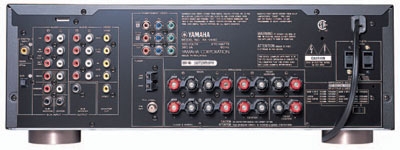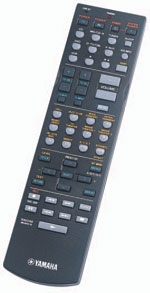Open Receivers Page 2
Yamaha RX-V440 The Yamaha RX-V440 has big-receiver looks that hinge on its two-knob front panel - one for volume, one for input selection - and the generous size and spacing of its primary controls. (But I was disappointed by its dim panel lettering. There's plenty of room for larger, brighter type.) The controls feel a good deal nicer than I expected a $300 box to manage, and the V440's overall heft was the most solid of the three. One small surprise was that the front-panel set of convenience inputs has only stereo line-level audio and composite-video jacks - no S-video. 
The reason became clearer when I turned to the back panel: the V440 has no S-video paths at all, relying on its two component-video inputs (a feature shared by all three receivers) for high-quality A/V sources. This saves a few bucks, obviously, and covers the essential bases of a progressive-scan DVD player and either an HDTV tuner, a high-def satellite receiver, or a video hard-disk recorder with a progressive-scan output. But if you have three or more such components, cable-swapping (or an external switch box) is in your future. The Yamaha also offers just two digital audio inputs and no digital outputs. (The V540, $100 more, adds another one of each - plus S-video jacks.) But the V440 does provide solid multiway binding posts for all its speaker outputs, including an extra stereo pair.
| YAMAHA RX-V440 | |
 | DIMENSIONS 17 1/8 x 6 3/8 x 15 3/8 inches WEIGHT 24 pounds PRICE $300 MANUFACTURER Yamaha, Dept. S&V, 6660 Orangethorpe Ave., Buena Park, CA 90620; www.yamaha.com; 800-492-6242 |
I found the RX-V440's setup routine a bit confusing. In common with our two other receivers, the Yamaha lacks onscreen displays, so you must use the front-panel readout. You press Set Menu and then use the cursor keys to navigate a skein of basic menus determining the number of speakers and whether there's a subwoofer in your system. Separate menu trees access individual speaker-size and digital-input assignments, a five-band, center-channel graphic equalizer, and a few more features. I had no real problems with any of this, but someone getting his first taste of the joys of multichannel home theater setup - a likely customer for this receiver - might have a little trouble.
If that newbie pays attention, though, he'll be well rewarded for his efforts, since the Yamaha performed exceptionally well at the key surround sound challenges. It had no difficulty with any of my standard Dolby Digital EX and DTS-ES movie-soundtrack checks, showing excellent detail and plenty of dynamic reserves. The Yamaha should provide ample power for most speaker systems and rooms; it sounded clean, clear, and effortless even at demanding volumes on a range of multichannel tracks from DVD-Audio discs and SACDs.
For those with a large stereo library (and isn't that all of us?), the RX-V440 offers the broadest array of options of our three receivers. A downsized but still potent selection of Yamaha's Hi-Fi and Cinema-DSP surround palettes amounts to a baker's dozen of digital signal processing modes and variants - not counting Dolby Pro Logic II (DPL II) and DTS Neo:6 - with nary a turkey among them. Yamaha uses reverb and delay in all channels of some modes, but they're carefully and realistically enough derived that I didn't find the effect objectionable.
What's more, you get to tweak the overall delay and DSP effect levels for each mode, giving you an impressive potential to match the mode to the music or movie of the moment. For instance, I usually prefer my film sound straight up, but the V440's Enhanced Dolby EX option made the clean and competent but otherwise somewhat narrow and flat soundtrack of The Good Thief subtly more alive and involving, especially in quiet interior scenes.
As irritating as I found the Yamaha's setup routine, its remote control was best in show by a slim margin over Panasonic's. Rather than trying anything fancy, Yamaha was content with spacing its buttons generously, using a variety of shapes and sizes, and intelligently organizing key-families by function or type. The white-on-gray of the primary lettering is legible, too. The handset also manages to provide direct-access keys both for the receiver's main surround modes and for its eight inputs - along with the requisite TV volume, channel, and input keys - without feeling the least bit crowded. You even get two extra "input" keys for controlling components or systems (lighting, say) without changing receiver inputs - a very thoughtful touch. (Alas, like the other two remotes here, the Yamaha's is preprogrammed only, with no way of learning obscure or obsolete codes from another remote.)
In short, Yamaha's RX-V440 is an amply powered, fine-sounding receiver that's easy and pleasant to use. It's also nicely finished and attractive, and it packs an awful lot - much of it genuinely useful. For $300, what more could you ask?
- Log in or register to post comments




















































